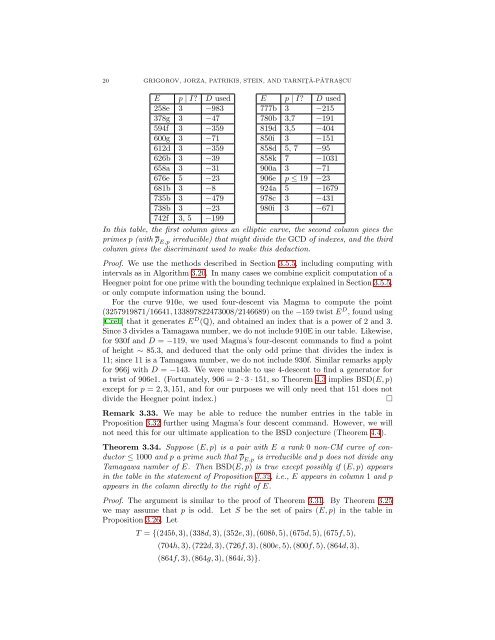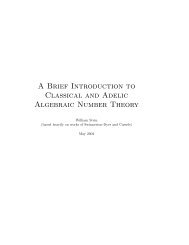COMPUTATIONAL VERIFICATION OF THE BIRCH ... - William Stein
COMPUTATIONAL VERIFICATION OF THE BIRCH ... - William Stein
COMPUTATIONAL VERIFICATION OF THE BIRCH ... - William Stein
You also want an ePaper? Increase the reach of your titles
YUMPU automatically turns print PDFs into web optimized ePapers that Google loves.
20 GRIGOROV, JORZA, PATRIKIS, STEIN, AND TARNIT¸ Ǎ-PǍTRAS¸CU<br />
E p | I? D used<br />
258e 3 −983<br />
378g 3 −47<br />
594f 3 −359<br />
600g 3 −71<br />
612d 3 −359<br />
626b 3 −39<br />
658a 3 −31<br />
676e 5 −23<br />
681b 3 −8<br />
735b 3 −479<br />
738b 3 −23<br />
742f 3, 5 −199<br />
E p | I? D used<br />
777b 3 −215<br />
780b 3,7 −191<br />
819d 3,5 −404<br />
850i 3 −151<br />
858d 5, 7 −95<br />
858k 7 −1031<br />
900a 3 −71<br />
906e p ≤ 19 −23<br />
924a 5 −1679<br />
978c 3 −431<br />
980i 3 −671<br />
In this table, the first column gives an elliptic curve, the second column gives the<br />
primes p (with ρ E,p irreducible) that might divide the GCD of indexes, and the third<br />
column gives the discriminant used to make this deduction.<br />
Proof. We use the methods described in Section 3.5.5, including computing with<br />
intervals as in Algorithm 3.20. In many cases we combine explicit computation of a<br />
Heegner point for one prime with the bounding technique explained in Section 3.5.5,<br />
or only compute information using the bound.<br />
For the curve 910e, we used four-descent via Magma to compute the point<br />
(3257919871/16641, 133897822473008/2146689) on the −159 twist E D , found using<br />
[Creb] that it generates E D (Q), and obtained an index that is a power of 2 and 3.<br />
Since 3 divides a Tamagawa number, we do not include 910E in our table. Likewise,<br />
for 930f and D = −119, we used Magma’s four-descent commands to find a point<br />
of height ∼ 85.3, and deduced that the only odd prime that divides the index is<br />
11; since 11 is a Tamagawa number, we do not include 930f. Similar remarks apply<br />
for 966j with D = −143. We were unable to use 4-descent to find a generator for<br />
a twist of 906e1. (Fortunately, 906 = 2 · 3 · 151, so Theorem 4.3 implies BSD(E, p)<br />
except for p = 2, 3, 151, and for our purposes we will only need that 151 does not<br />
divide the Heegner point index.) <br />
Remark 3.33. We may be able to reduce the number entries in the table in<br />
Proposition 3.32 further using Magma’s four descent command. However, we will<br />
not need this for our ultimate application to the BSD conjecture (Theorem 4.4).<br />
Theorem 3.34. Suppose (E, p) is a pair with E a rank 0 non-CM curve of conductor<br />
≤ 1000 and p a prime such that ρ E,p is irreducible and p does not divide any<br />
Tamagawa number of E. Then BSD(E, p) is true except possibly if (E, p) appears<br />
in the table in the statement of Proposition 3.32, i.e., E appears in column 1 and p<br />
appears in the column directly to the right of E.<br />
Proof. The argument is similar to the proof of Theorem 3.31. By Theorem 3.25<br />
we may assume that p is odd. Let S be the set of pairs (E, p) in the table in<br />
Proposition 3.26. Let<br />
T = {(245b, 3), (338d, 3), (352e, 3), (608b, 5), (675d, 5), (675f, 5),<br />
(704h, 3), (722d, 3), (726f, 3), (800e, 5), (800f, 5), (864d, 3),<br />
(864f, 3), (864g, 3), (864i, 3)}.
















